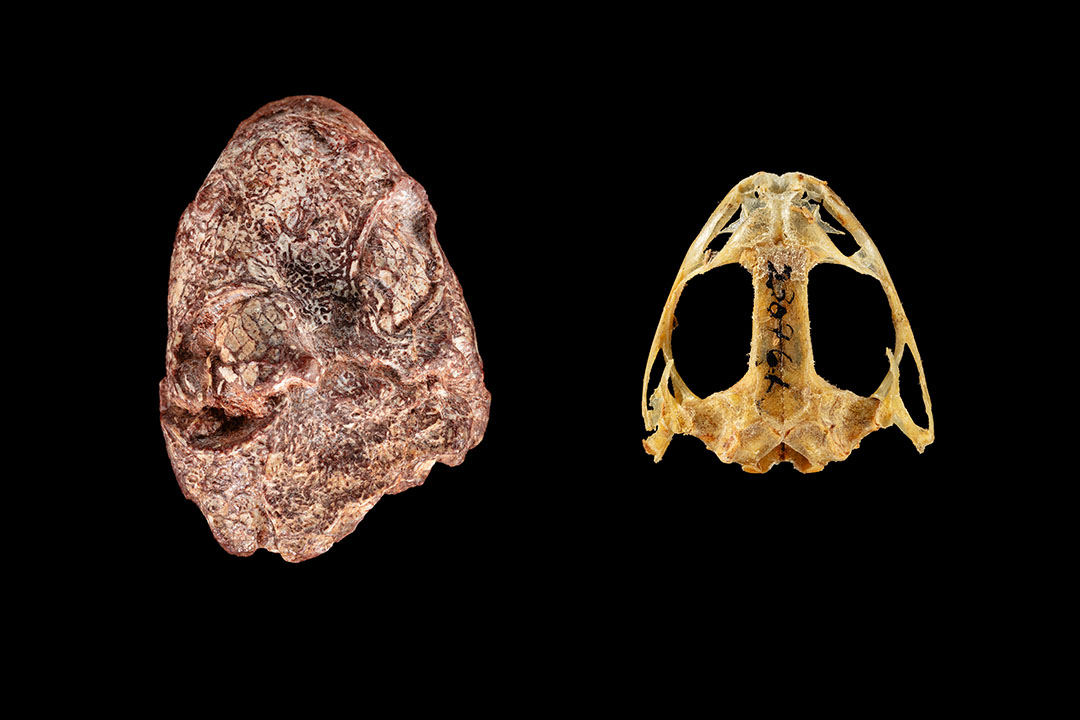It’s not green. It’s not cuddly. And it’s not even really a frog—as we know it.
But Kermitops gratus, an ancient species discovered by researchers including George Washington University doctoral student Cal So and named for Kermit the Frog, may change our understanding of the amphibian family tree.
And its name, paying tribute to the lovable plush Muppet, is part of a plan to excite the public about scientistic discoveries.
“We thought it was appropriate to name the fossil after a modern day representative of the whole amphibian family tree—Kermit the Muppet,” said So, a fifth-year doctoral student in the Department of Biological Sciences at the Columbian College of Arts and Sciences and the lead author of a new paper on the discovery in the “Zoological Journal of the Linnean Society.”
“We wanted to bring attention to the artfulness and playful creativity that scientists and paleontologists have and bring the fossil to a broader audience than it normally would have with perhaps a more technical name,” So said.
So was among the scientists who uncovered the fossilized skull of a 270-million-year-old ancient amphibian ancestor in the collection of the Smithsonian’s National Museum of Natural History.
The skull—which measures just over an inch long and possesses large, oval-shaped eye sockets—was originally unearthed 40 years ago by the late paleontologist and curator in the museum’s paleobiology department Nicholas Hotton III.
Its unique characteristics—including a mishmash of traits that are different from features seen in the skulls of older tetrapods and other living four-legged vertebrates—signaled to the researchers that it was a new species of proto-amphibian.
In particular, So said, the region of the skull behind the animal’s eyes was much shorter than its elongated, curved snout, which may have helped it snap up tiny grub-like insects. In addition, So noticed a tiny bone at the back of the skull that disrupted “the general narrative” of how researchers perceived amphibian evolution.
“That extra bone is one of the key features that tells us the steps of amphibian evolution didn’t just go one way—they went this way and that way and another way,” So said.
Kermit look-alike
Hotton spent several field seasons excavating fossils from rock outcrops in north central Texas known as the Red Beds. The area’s rust-colored rocks date back to the early Permian period more than 270 million years ago and contain the fossilized remains of ancient reptiles, amphibians and sail-backed synapsids, the precursors to modern mammals.
The excavation team collected so many fossils that they were unable to study all of them in detail, including the small proto-amphibian skull unearthed in a rock layer known as the Clear Fork Formation in 1984. The skull was deposited in the Smithsonian’s National Fossil Collection, where it spent decades waiting for researchers to take a closer look.
In 2021, Arjan Mann, a postdoctoral paleontologist at the museum, was sifting through Hotton’s trove of Texas fossils when one specimen labeled as an early amphibian caught his eye.
“One fossil immediately jumped out at me—this really well-preserved… skull,” said Mann, a co-author on the new paper.
Mann and So teamed up to identify the fossil as a temnospondyl, a diverse group of primitive amphibian relatives that lived for over 200 million years from the Carboniferous to the Triassic periods. But because the animal’s skull sported such singular features, the scientists concluded that it belonged in an entirely new genus, which they named Kermitops.
GW doctoral student Cal So (right) and Smithsonian postdoctoral paleontologist Arjan Mann with the fossil skull of Kermitops in the Smithsonian’s National Museum of Natural History fossil collection.
So, who admitted they “were always a little bit terrified of the Muppets” as a child, said the fossil’s features actually resemble the beloved frog character created by puppeteer Jim Henson in 1955.
“The way it was preserved and slightly crushed, it had a goofy smile and a bug-eyed appearance that looks like Kermit,” So laughed. “We hope naming it Kermitops helps change how some people relate to fossils moving forward.”
The species name gratus represents the researchers’ gratitude for Hotton and the rest of the team that originally unearthed the fossil.
Meanwhile, the researchers call the Kermitops discovery the latest step in fitting early branches to the amphibian family tree. The early fossil record of amphibians and their ancestors is largely fragmentary, So said, which makes it difficult to understand how frogs, salamanders and their kin originated.
“With this discovery, we now understand that there is a lot of underlying complexity in the steps it took to acquire the modern amphibian skull shape that we see today,” So said. “It’s important because we have a lot of gaps in our understanding of modern amphibian evolution and any bit of information is really helpful.”
Mann agreed and hoped that the discovery of a previously unknown amphibian ancestor hiding in plain sight will inspire other paleontologists to take a closer look at their own museum’s fossil collections.
“This is an active area of research that a lot more paleontologists need to dive back into,” he said. “Paleontology is always more than just dinosaurs, and there are lots of cool evolutionary stories and mysteries still waiting to be answered. We just need to keep looking.”
The new project is the latest example of the Smithsonian’s history of collaboration with GW, which provides the university’s students with access to the collections and resources of the world’s largest museum and research complex. The new paper also includes a co-author from the Field Museum of Natural History.
Portions of this article were adapted from a Smithsonian National Museum of Natural History press release.



